What’s New in Air Freight Logistics This Year
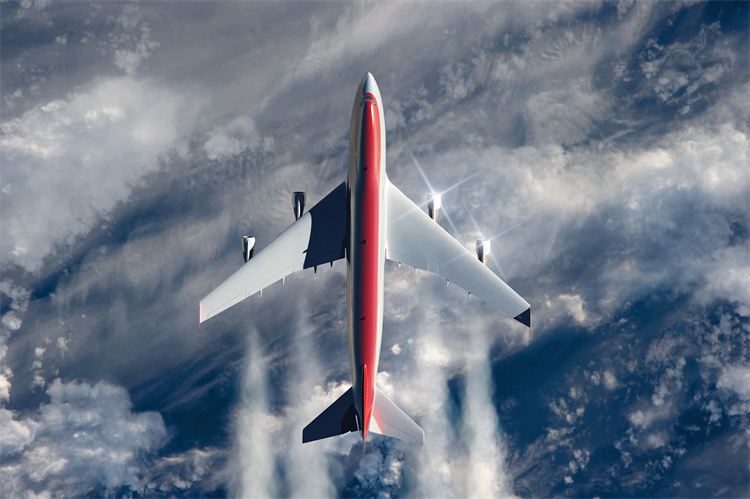
Air freight logistics in 2025 is changing fast. Reports say people feel hopeful. About 84.6% of airfreight workers think volume will grow. Some big changes are happening:
E-commerce demand, mostly from Asia, helps air freight grow.
New rules and sustainability needs change how things work.
Sourcing changes affect air freight routes and planning.
JUSDA is leading these changes by always improving and using smart logistics solutions.
Key Takeaways
Air freight is getting bigger in 2025. E-commerce and Asia-Pacific demand are making it grow. New rules and price changes are changing the market.
Technology like AI, automation, and digital platforms help companies plan better. They also help track shipments right away. These tools lower costs and mistakes.
Green logistics and strong partnerships make air freight safer and cleaner. They also help the system follow new safety and environmental rules. The system becomes more flexible too.
Air Freight Market Trends
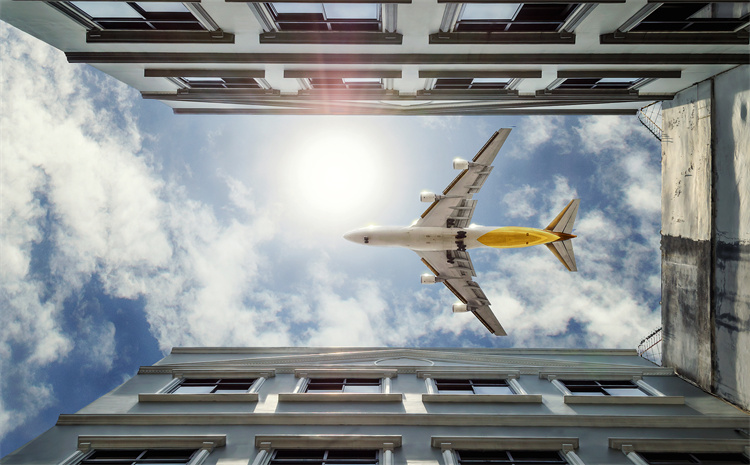
Demand and Capacity
The air freight market is getting stronger in 2025. Experts say air cargo will go up by 5.8%. This means 72.5 million tonnes will be shipped. For 18 months, cargo demand has kept growing. In January 2025, it was 3.2% higher than last year. There is more space for cargo now, too. Capacity is up 6.8% from last year and is better than before COVID. Asia-Pacific is leading this growth. Demand there is up 7.5%, and capacity is up 10.9%. North America and Europe are also doing well, but not as fast.
Metric/Region/Trade Lane | Growth/Change | Notes |
|---|---|---|
Global Air Cargo Volume Growth (2025) | +5.8% | Predicted increase reaching 72.5 million tonnes (IATA) |
Cargo Demand (Year-on-Year, Jan 2025) | +3.2% | 18 consecutive months of growth |
Cargo Capacity (Year-on-Year, Jan 2025) | +6.8% | Capacity recovery above pre-COVID levels |
Cargo Revenues (2025 forecast) | $157 billion | Significant revenue growth |
Asia-Pacific Demand Growth (Jan 2025) | +7.5% | Strong regional performance |
Asia-Pacific Capacity Growth (Jan 2025) | +10.9% | Highest regional capacity increase |
North America Demand Growth (Jan 2025) | +5.3% | Positive growth despite some regional weakness |
North America Capacity Growth (Jan 2025) | +7.5% | Capacity increase supports demand |
Europe Demand Growth (Jan 2025) | +1.3% | Moderate growth |
Europe Capacity Growth (Jan 2025) | +3.5% | Capacity increase |
Trade Lane Growth: Asia-North America | +6.1% | 15 consecutive months of growth |
Trade Lane Growth: Europe-Asia | +3.2% | 23 consecutive months of growth |
Trade Lane Growth: North America-Europe | +9.7% | 12 consecutive months of growth |
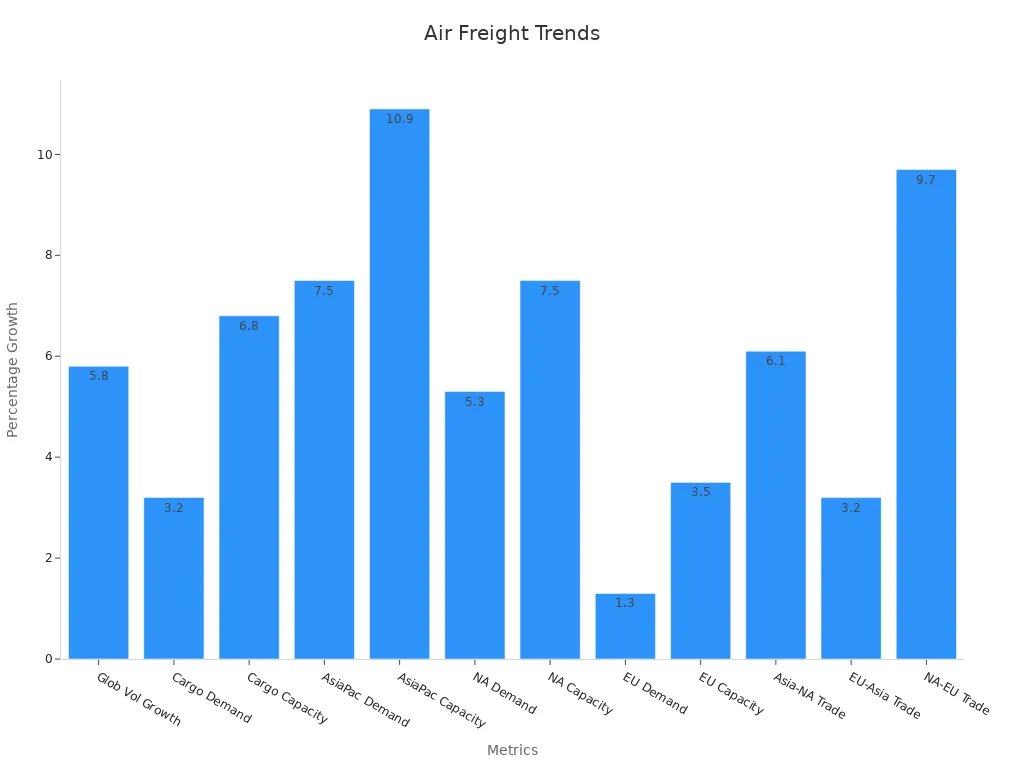
Air freight keeps growing because of e-commerce and factories. E-commerce is growing 14% each year around the world. In China, it jumped 35% in 2024. More semiconductors are being shipped, up about 10%. These things make air cargo more needed and change the market.
JUSDA helps people deal with these changes. They have over 155 service points and warehouses in important places. JUSDA gives real-time updates and flexible help. They work with electronics, cars, and FMCG. Their JusLink system lets clients track shipments and react fast to changes.
Pricing Shifts
In 2025, air freight prices are changing in new ways. Prices go up or down because of tariffs, rules, and supply chain changes. The Baltic Air Freight Index shows prices from Shanghai to North America dropped to $5.17 per kilogram. This is because e-commerce demand is lower and tariffs changed. But prices from Frankfurt to the USA went up to $3.17 per kilogram. This is because more people want to ship things across the Atlantic. London Heathrow to North America stays at $1.87 per kilogram. This is because of high-value shipments.
Trade Lane / Route | Baltic Air Freight Index (BAI) Code | Price (USD/kg) | Change | Market Insight Summary |
|---|---|---|---|---|
Shanghai to North America | BAI82 | 5.17 | -0.12 | Tariff-driven softening; decline in e-commerce demand impacting Transpacific rates |
Frankfurt to USA | BAI24 | 3.17 | N/A | Rising rates reflecting robust Transatlantic demand |
London Heathrow to North America | BAI42 | 1.87 | N/A | Strong demand for high-value industrial shipments |
Singapore to Southeast Asia | BAI63 | 0.79 | -0.17 | Steady intra-regional trade despite slight decline; growth in Southeast Asia manufacturing hub |
Hong Kong to Southeast Asia | BAI33 | 2.08 | N/A | Increasing intra-Asia trade supported by logistics investments |
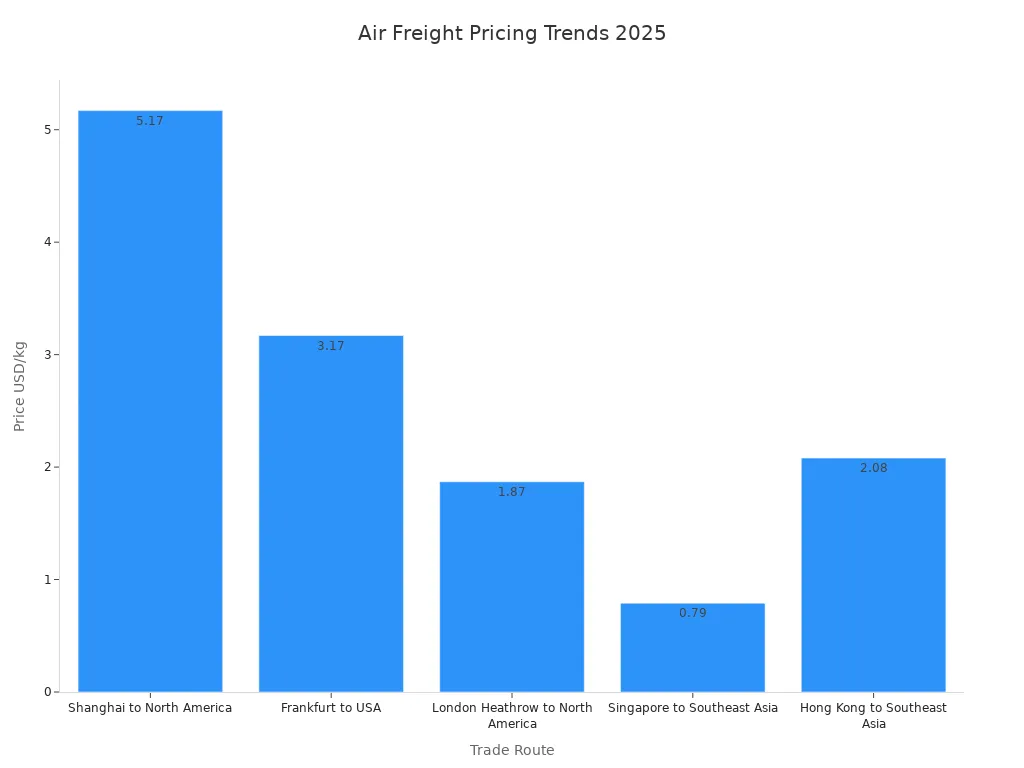
Prices also change when there is less space for cargo. Delays in making planes and retiring old ones mean less room. This makes lease prices go up. Southeast Asia is making more things, so demand there is higher. On transpacific routes, some shippers use ocean freight instead of air for e-commerce.
JUSDA’s experts help clients handle these price changes. They use smart tools to guess future prices and find the best way to ship. JUSDA’s network helps clients get space even when the market is tough. Their digital tools give updates, so businesses can plan and save money.
Note: The air freight market in 2025 keeps changing. Companies that use data and smart logistics, like JUSDA, can handle changes in demand, space, and prices better.
Regulations
Safety and Compliance
Air freight safety rules are much tougher in 2025. Aviation authorities now want all cargo screened. They also need more background checks for workers. New paperwork rules help stop cargo tampering. Audits happen more often now. Breaking the rules means bigger fines. Cargo theft and tampering get worse during busy times. Holidays and the fourth quarter are risky. In the last five years, 174 cargo thefts happened at Thanksgiving. These thefts caused $7.84 million in losses. After Christmas, about 31 cargo thefts happen each day.
To keep shipments safe, companies do many things:
Work with TSA-approved carriers
Use tamper-proof packaging and security seals
Add real-time GPS tracking
Give regular compliance training and audits
International standards from ICAO, FAA, and EASA set the rules. These rules cover equipment design, maintenance, and import compliance. Following these standards helps avoid customs delays. It also keeps supply chains working well. JUSDA helps clients by using advanced tracking. They keep strict paperwork and train staff often to meet safety needs.
Customs and Trade
Customs and trade rules changed in 2025. The EU’s Import Control System 2 (ICS2) now needs more security data before air shipments arrive. Cargo going to the EU must have ACC3 designation. This means it passed strict screening or comes from a safe supply chain. The European Aviation Safety Agency has new rules for airport safety and ground handling. In the US, the Air Cargo Advanced Screening (ACAS) program now asks for more shipment details from Europe and CIS countries.
These changes make following the rules harder and can cost more. JUSDA helps clients by keeping up with new rules. They handle customs paperwork and use digital tools to track shipments. Their global team works with customs to stop delays and keep trade moving for every shipment.
Tech Advances
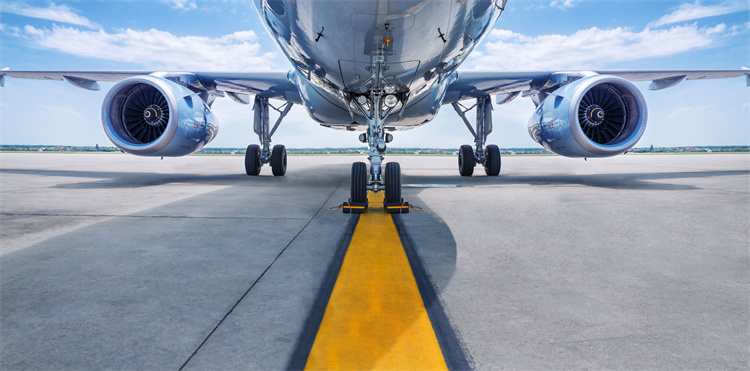
AI and Automation
AI and automation are making logistics easier in 2025. Many companies now use smart systems to plan routes and track shipments. These systems can also spot problems before they happen. This helps save fuel, avoid delays, and keep cargo safe. JUSDA’s JusLink AI Solution uses special analytics to guess demand and pick the best routes. It also checks for risks right away. Robots in warehouses and sorting machines help process orders faster. They also lower mistakes made by people. AI security tools watch over cargo and stop theft. This makes the supply chain safer and more trustworthy.
Performance Metric | Description | Impact on Operational Efficiency |
|---|---|---|
Fuel Optimization | AI-based route planning and predictive analytics optimize routes to reduce fuel consumption. | Lowers fuel costs and reduces unnecessary idling and congestion. |
Predictive Maintenance | AI telematics monitor vehicle health to predict and prevent breakdowns. | Decreases maintenance costs and vehicle downtime. |
Smart Scheduling & Load Distribution | AI optimizes shipment scheduling and load balancing to maximize truck capacity and reduce empty miles. | Minimizes operational costs and improves fleet utilization. |
Reduced Delivery Time | AI-driven demand forecasting and warehouse efficiency speed up order processing and delivery. | Enhances delivery speed and customer satisfaction. |
AI-Driven Security & Tracking | AI-enabled GPS and IoT sensors provide real-time cargo visibility and theft prevention. | Improves cargo security and supply chain reliability. |
Autonomous Trucks | AI-powered self-driving trucks operate continuously and optimize routes. | Increases fleet productivity and reduces human labor dependency. |
AI-Powered Drones | Drones enable faster, contactless deliveries, especially in hard-to-reach areas. | Speeds last-mile delivery and expands delivery capabilities. |
Operational Cost Savings | Overall reduction in fuel, maintenance, labor, and error-related costs due to AI and automation. | Improves cost efficiency and sustainability in logistics. |
Digital Platforms
Digital platforms are now very important in logistics. Smart airports and digital customs let people use paperless documents. They also let you track shipments safely and in real time. IoT and blockchain help everyone see where shipments are at any moment. These tools also help stop fraud. Automation and AI help move shipments faster and stop slowdowns. Platforms like JUSDA’s JusLink bring shippers, airlines, and freight forwarders together on one screen. This makes it easier to talk, shortens wait times, and helps people make good choices. Digital tools also mean less paperwork and fewer mistakes. This makes air freight management quicker and more correct. Today, real-time info and digital shipment tools are needed to stay ahead.
Sustainability
Green Logistics
Green logistics is getting more important in 2025. Many countries now have tough rules to cut carbon emissions. Airlines and logistics companies spend money on sustainable aviation fuels and cleaner tech. The Pine Bend refinery in Minnesota wants to make up to 1 billion gallons of SAF each year. Big companies like Deloitte and Bank of America help these projects. United Airlines puts money into carbon reduction tech, like direct air capture for cleaner jet fuel.
Region | SAF Mandate / Target | Key Projections / Targets | Financial Incentives & Support | Infrastructure & Other Initiatives |
|---|---|---|---|---|
UK | SAF mandate starts at 2% in 2025, rising to 10% by 2030 | SAF must achieve minimum 40% GHG reduction | £165 million in grants, SAF Clearing House | Grants for SAF storage and distribution |
EU | 2% SAF in 2025, up to 70% by 2050 | €1.7 billion in SAF allowances, €40 billion Innovation Fund | Auctioned allowances, Clean Aviation Joint Undertaking | Investments in SAF plants, MRV for emissions |
US | No federal SAF mandate, but state programs drive demand | 3 billion gallons of SAF by 2030 | Federal and state tax credits, grants | FAA grants for SAF hubs, Pine Bend refinery |
Eco Initiatives
Green logistics helps in real ways. Studies say better service and faster customs use less fossil fuel and lower carbon emissions. If service quality drops by 1%, CO2 emissions go up by 0.011%. Delays in moving cargo also raise emissions. When companies work faster and better, they help the planet and make more money for the country. JUSDA is a leader in this. They use smart warehouse systems and real-time tracking to waste less and save energy. JUSDA’s clean rooms follow strict environmental rules. Their focus on good logistics helps the economy and keeps the planet cleaner.
Note: Air freight’s future needs strong logistics that are both efficient and green. Companies like JUSDA show how smart logistics can help the earth and business at the same time.
E-commerce & Special Cargo
Online Retail Growth
E-commerce is changing logistics a lot in 2025. Now, about half of air freight shipments come from online shopping. This makes air cargo demand higher than ever. The global market is worth $160.10 billion and grows 6% each year. North America has the biggest share at 36.9%. Asia Pacific is growing fastest because of more factories and online sales. Each month, air cargo demand is over $23 billion. This is more than before the pandemic. New U.S. tariffs on goods from China, Canada, and Mexico make companies ship faster. This causes short-term jumps in air freight. Changes in e-commerce rules, like new de minimis limits, could change delivery times and costs. This matters most for shipments from China to the U.S.
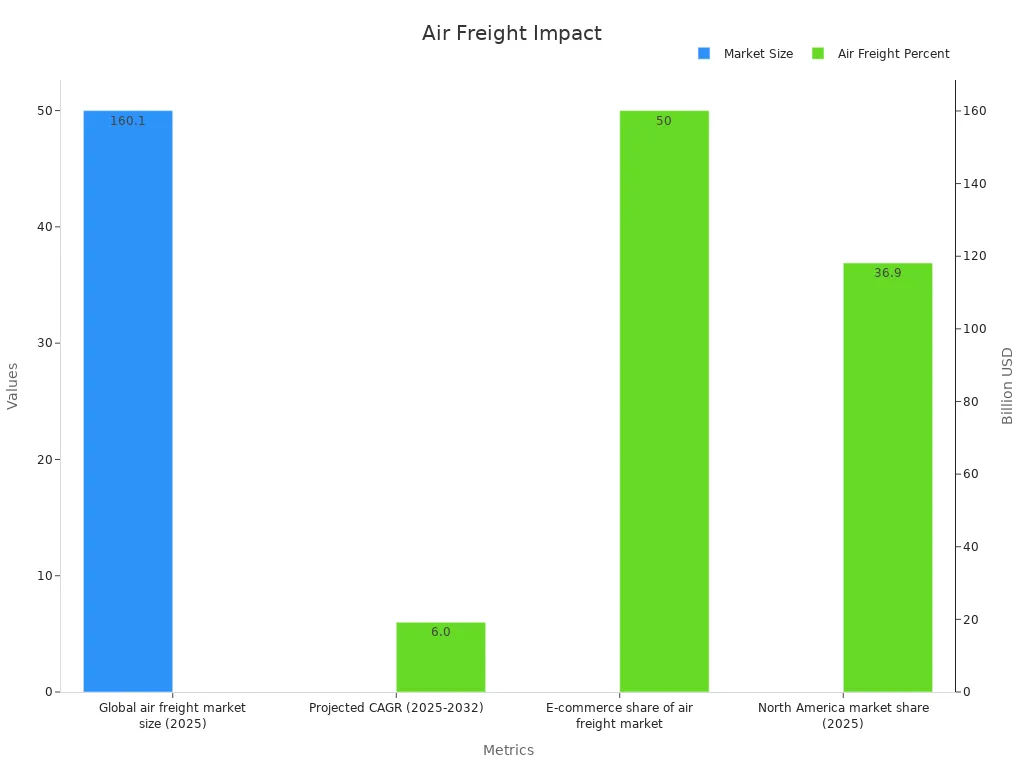
E-commerce growth means companies need faster and more reliable shipping. They must adjust quickly to new trade rules and patterns.
Specialized Handling
Special cargo needs extra care and special logistics. Things like electronics, car parts, and FMCG must be handled carefully. Air cargo moves over $6 trillion in goods every year. That is about 35% of world trade by value. Items like semiconductors and perishable goods need special packaging and labels. They also need the right paperwork. Global standards help keep these goods safe and moving fast. In 2023, international air cargo was 56.12% of the market. Asia Pacific leads because it makes a lot of goods.
JUSDA helps with these needs using special warehouse solutions. Their buildings have smart systems to track inventory in real time. They use clean rooms for sensitive products. JUSDA’s network supports electronics, car parts, and FMCG with safe storage and quick delivery. Their skills help clients follow strict rules and keep products in good shape all over the world.
Sector/Region/Segment | Key Figures (2023) | Implication for Specialized Handling in Air Freight |
|---|---|---|
International Air Cargo Market | High-value goods like electronics and car parts need special handling | |
Asia Pacific Region | 37.64% market share | Makes lots of electronics, cars, and goods, so needs special logistics |
Air Freight Segment | 61.59% market share | Best for high-value, urgent goods needing speed and safety |
E-commerce Growth | Significant driver | Needs fast, safe, and secure shipping for electronics, FMCG, and car parts |
Specialized Cargo Types | Includes temperature-sensitive, fragile, and high-value goods | Needs special packaging, labels, and handling to stay safe and efficient |
Adapting Strategies
Resilience
Air freight logistics in 2025 needs to be very strong. Companies deal with changing demand and new rules. Trade routes also change often. To keep up, logistics workers use smart strategies.
They use digital tools and platforms. These help them work faster and see updates right away.
They care about the environment. They use Sustainable Aviation Fuels and green habits to reach net-zero goals.
They make smart partnerships and stay flexible. This helps them change plans fast and give special solutions.
They move into new places like Vietnam and Turkey. This lowers risk and helps them grow.
They fix problems with space and demand by offering flexible choices.
They use new technology like artificial intelligence and automation. This makes things faster and more flexible.
Studies show these steps help companies handle problems and keep things running well. Using digital tools, caring for the planet, and trying new ideas are important for strong logistics.
Collaboration
Working together is shaping the future of logistics. Digital tools help teams work better and make supply chains stronger. For example:
Blockchain lets all partners see shipment data right away. This makes things safer and clearer.
IoT sensors watch cargo conditions like temperature. Companies can fix problems quickly if something goes wrong.
AI guesses when problems might happen. It helps teams plan better.
Digital twins let companies test plans before using them for real.
Digital platforms, like JUSDA’s JusLink, help partners make quick choices and offer flexible help.
These tools help companies spend less, avoid waiting, and keep goods moving. When teams work together and use smart tech, they build a supply chain that can handle any problem.
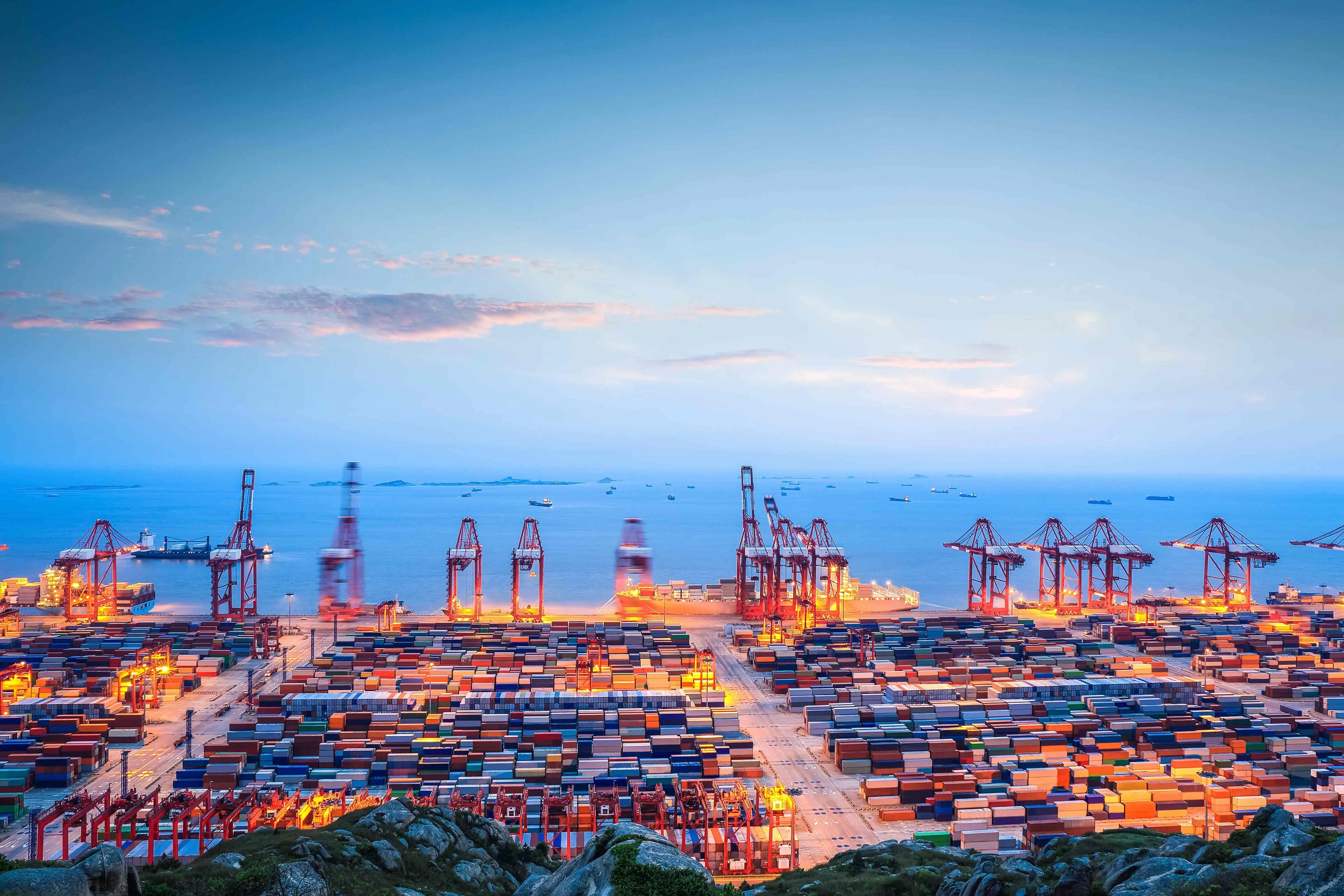
JUSDA Solutions
To provide you with professional solutions and quotations.
The logistics industry is changing quickly in 2025. Companies are spending money on AI, automation, and green ideas. Digital customs and smart warehouses help things move faster and make fewer mistakes.
Robots and automation help workers make fewer errors. They also help get work done faster.
Watching carbon footprints and picking greener choices help companies follow rules. It also helps customers trust them more.
JUSDA’s new logistics solutions help businesses stay quick and strong against others.
See Also
Exploring The Latest Innovations In Sea Freight Logistics
Understanding Emerging Trends In Logistics Risk Management
Key Reasons To Join Leading Logistics Webinars Today
Best Five Logistics Training Programs To Watch In 2024
How Artificial Intelligence Is Transforming Future Supply Chains
